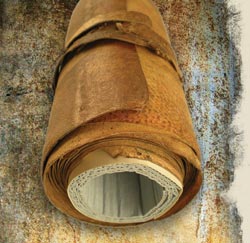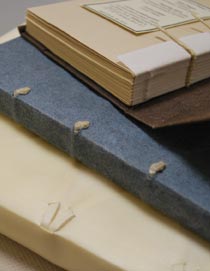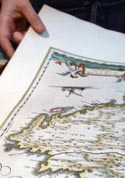
Library books don’t always age gracefully. They get dropped, their covers nicked, their spines cracked, their pages penciled and stained. Paper is perishable. Even when handled gently, it can crumble on the shelf if it’s too acidic or disintegrate if the roof springs a leak. The same goes for almost everything else libraries collect. Eventually every book, map, photo, and cherished manuscript in Duke’s hallowed stacks will succumb to age, use, or chemical processes—not to mention every film, video, audio recording, and digital file.
Not to be all gloom and doom. In the library world, as in the real one, the best view is usually the long view. When your mission is to collect, organize, and preserve the world’s knowledge and pass it on the next generation, the long view isn’t simply a matter of perspective. It’s what guides almost everything librarians do.
Nowhere is that sense of perspective more evident than in the Libraries’ Preservation Department. You could think of Preservation as the Libraries’ longevity department. It’s where torn pages are mended, outdated formats are reformatted, and long-range policies are crafted before library materials ever reach the hands of the people who use them, so that they can keep being used for a long, long time. The work of the Preservation staff encompasses a broad range of activities, from maintaining the Libraries’ general collection to book and materials repair, user education, environmental monitoring, disaster preparedness and recovery, and even working with national organizations to figure out long-term solutions for storing and preserving the nation’s common cultural resources.

Consider the Verne and Tanya Roberts Conservation Lab. The vast majority of people who walk into Perkins Library don’t even know it’s there, but the entire university benefits from what goes on inside. Tucked away in a secure nook below ground, the room is something of a cross between a chemistry lab and an artist’s studio. Workbenches line the wall, where a team of conservators wield an array of special tools, from scalpels and bone folders to cast-iron presses and board shears. Worn and damaged volumes lay before them like hospital patients, their guts in various stages of delicate surgery. The conservators perform a range of technical tasks, from the simple mending of torn pages to more complicated treatments like rebinding seventeenth-century atlases and halting the devastation of mold. It’s intricate, time-consuming work, equal parts scientific know-how and time-honored craft.
In other parts of the library, similar activities are going on—only instead of surgery, think cryogenics. (But without the creepy factor.) The preservation of digital library resources is a massive undertaking which only promises to get bigger. With help from Preservation staff, some of the Libraries’ most important documents are being digitally frozen in time, preserved in new formats that will, with luck, outlast the originals. Immense flatbed and overhead scanners, high-definition cameras, video decks and audio remastering equipment give new life (and new uses) to old and fragile materials. Some of the more hard-working scanners in Duke’s Libraries can digitize hundreds of book pages an hour. The computer files they crank out devour megabytes and gigabytes, piling up a truly massive amount of data. Accommodating such enormous files isn’t just about putting the Libraries’ computer systems to the test. It’s another form of librarianship.
Welcome to the modern world of library preservation. In today’s academic libraries, the work of preserving library materials is a highly specialized business. It combines art and science, old-fashioned tools and high-tech computers, tangible artifacts and intangible bits and bytes. Without it, some of our most valuable scholarly resources would be in a lot shabbier shape.
This year, the Duke University Libraries Preservation Department officially turned ten. The staff celebrated the occasion with an exhibit, a new blog, and a series of videos. In this issue of the magazine, we wanted to continue the celebration by highlighting the important work they do, and the dedicated people who do it. Their accomplishments, we think you’ll agree, are as fascinating as they are vital to preserving our intellectual heritage.
Preservation on the Web: library.duke.edu/about/depts/preservation/
Go there and you can also find links to the Preservation’s Facebook, Flickr, and Twitter pages.
Meet the Staff

Winston Atkins, Preservation Officer
Winston came to Duke ten years ago to start the Preservation Department. He oversees the Conservation Program as well as general preservation activities in the library. In addition to his role in planning and managing the Department, he has a strong interest in cooperative preservation projects and in the Libraries’ initiatives to provide access to the digital resources it creates or receives for our future users. He is now working on a committee that is charged with developing a campus repository for digital materials.

Beth Doyle, Head of Conservation Services
Beth has been at Duke Libraries for eight years. She ensures that the staff in the Verne and Tanya Roberts Conservation Lab has enough work and the supplies they need to work on the collections. She also spends time planning the future of Conservation Services in order to make sure the collection is well cared for. Beth works closely with staff in the Digital Production Center and with the Exhibits Coordinator to ensure the safe reformatting and display of our collections. Her bench work tends to focus on creating custom enclosures for odd things found in the stacks, such as pink felt dragons or model airplanes. “There is nothing I can’t make a box for, no matter its size or shape,” Beth says. She also likes to work on flat paper materials such as maps and manuscript materials.

Mary Yordy, Senior Conservation Technician
Mary has worked in conservation for 10 years. Last fiscal year, Mary repaired 925 books and manuscripts from the collections and created over 2,000 protective enclosures. She is an avid bookmaker who has taught classes in bookmaking both in the library and the community.

Erin Hammeke, Conservator for Special Collections
Erin has worked in Conservation for three years. She has completed a large number of treatments in the Harold Jantz Collection of German Baroque Literature and German Americana, thanks in large part to a generous grant from Dr. Eleanore Jantz. “I love working with this collection because it seems to have everything—both in terms of content (there are materials that pertain to history, travel, the occult, women’s writings, and more) and in terms of different binding styles and material,” says Erin.
Currently Erin is working on other books from the Rare Book, Manuscript, and Special Collections Library, including a volume of DeBry’s account of the New World and six large Dutch atlases printed in the 1600s by Willem Janszoon Blaeu.

Meg Brown, Conservator for Special Collections
Meg has been a special collections conservator for Duke University Libraries for over five years. She is also the Libraries’ Exhibits Coordinator and responsible for student exhibits and displays in Perkins Gallery. What she enjoys most about conservation is “saving materials that are so fragile that patrons can’t use them unless Conservation treats them.”
Most of the materials Meg works on come from Research Services because they are difficult or impossible to handle safely. Our mission as a library is to put materials in the hands of users. “It’s a great feeling to know that I have helped researchers by conserving library materials,” says Meg.
Lab Notes
An Up-Close Look at Some Treatments from the Verne and Tanya Roberts Conservation Lab
Spinal Exercises
This set of eighteenth-century French legal journals was in fairly good condition except that each volume had a broken or missing spine. Mary Yordy, Senior Conservation Technician, used this set to demonstrate the five steps taken to repair the volumes.

Left to right: First the old spine is carefully removed and, if possible, will be put back on the new binding. The old glue and spine liners are cleaned off, exposing the text block paper and sewing. New spine liners of Japanese tissue, cotton cloth and paper are attached. The old spine is re-adhered and any losses are filled with paper so that the new spine is smooth. Finally, Mary places a toned Japanese tissue over the new fills to make them less noticeable and to reinforce the outer joints.
Once complete, this set will go back to the Perkins stacks ready for the next patron to use.

Theatrum Orbis Terrarum
This six-volume world atlas was created and published between 1648 and 1655 by Willem Janszoon Blaeu and his son, Joan Blaeu, two of the finest mapmakers of the seventeenth century. These folio volumes are full of engraved maps and vignettes that were hand-colored with a strikingly vibrant palette. They are bound in gold-tooled stiff-board vellum bindings.
Erin Hammeke, Special Collections Conservator, noted that the atlases are in fairly good condition considering their age but would still need several hours of work. Each atlas requires surface cleaning to remove dirt and debris from the covers and individual pages. To do that, she uses soft brushes, special erasers, and a museum vacuum specifically made for gently cleaning fragile objects. Erin then mends the tears with wheat starch paste and Japanese and Korean tissues. Finally, each volume will receive a custom-made enclosure to protect the book from wear and tear.
Boxing the Blue Devil
This doll was donated to the Duke University Archives in honor of the retirement of Tom Harkins, who retired from the Archives this spring. It was purchased on campus in 1938. It is very fragile and the Archives asked us to create a custom box to protect it.

Beth Doyle, Head of Conservation Services, started by making an inner box to cushion the doll. The inner box is made with buffered corrugated board lined with polyester quilt batting and cotton fabric. Bolsters were made with lightweight plastic “air pillows” similar to those used in shipping books. These would keep the doll from rolling around in the box and sustaining more damage. A custom-fit drop-spine box was then created to house the inner box and doll.
Visit the Conservation Lab’s “Boxing the Devil” set on Flickr to see more images from this project.
Ten Tips for Ten Years
Helpful Advice for Preserving Your Own Precious Collections from the Duke University Libraries Preservation Staff
Concerned about that fading quilt you inherited? Thinking about digitizing some old black-and-white photos? Here are tips from the Libraries’ Preservation staff to help ensure that your family heirlooms and works of art are available for future generations to enjoy.
Tip 1: Provide a Good Environment
Keep your materials in a stable environment. Avoid high temperature and humidity, water damage, mold, and mice and insect feasts. If you discover a problem, contact a professional conservator for advice immediately.
Tip 2: Provide Proper Enclosures
Enclosures provide protection from light, dust and handling. Use an appropriate size—enclosures that are too small or too large may cause damage. Enclosures made of paper should have a pH between 7.0 and 8.5 and be lignin free, or they will become brittle. Plastic enclosures such as slide or page protectors should be made of polyester (trade names Mylar and Melinex), polypropylene, or polyethylene. If you can’t determine what type of plastic it is, don’t buy it. Avoid vinyl because it can accelerate deterioration of paper and photographs.
Tip 3: Handle With Care
Do not eat or drink around collections. Wash and dry your hands, especially before handling photographs and textiles, which are very sensitive to body oils and dirt. Make sure you have a place to put it before taking it out. Don’t pull books off shelves by their head caps, get fingerprints on your photos, and avoid paperclips and sticky notes. Handle with care. Handle with care. Handle with care.
Tip 4: Display responsibly
Keep photographs and artwork away from light to avoid fading. Choose good framing materials. Choose a mat board with 7.0-8.5 pH, glass or Plexiglas glazing, and non-adhesive backing.
Tip 5: Consider Using Copies or Facsimiles
Consider displaying a high-quality reproduction and safeguarding the original.
Tip 6: Be Prepared For Disasters
Have a disaster plan for yourself and your most treasured stuff.
Tip 7: Preserving Non-paper Collections
Textiles: Textiles are very sensitive to environmental and alkaline conditions, especially light and pollutants. Choose enclosures and wrapping materials that are pH neutral (pH of 7.0-7.5).
Cleaning should be undertaken very carefully and follow established conservation guidelines (read: consult a professional).
Photographs and Home Movies: Photos and film are very sensitive to the environment around them. If you have a choice, use pH neutral enclosures. Consider creating high-quality facsimiles and digitizing the originals.
Digital objects: Create backups often and in the most current formats. Multiple copies reduce the risk of total loss. Store your originals safely. Don’t discard them!
Tip 8: Access and Preservation Go Together
Provide who/what/where/when for photos and documents. Use a pencil to write on the back of photographs. Someday you’ll be glad you took the time. Or digitize the image and add the information to the digital file.
Inspect items regularly for mold and insect damage.
Organize and identify items. Document your documents. Describe valuables and take pictures of them, perhaps part of a home inventory or for insurance purposes.
Tip 9: Be an Informed Consumer
There is a lot of misinformation out there when it comes to preservation and conservation instructions. Be an informed consumer when searching the web or watching television. There are some excellent online resources out there that offer solid advice, including:
- Library of Congress Preservation Directorate: loc.gov/preserv
- Northeast Document Conservation Center: nedcc.org
- National Archives and Records Administration: archives.gov
- Lyrasis: lyrasis.org
- American Institute for Conservation: conservation-us.org
Tip 10: Leave the Repairs to the Professionals
Sure, you can tape book pages together or attempt a DIY book repair, but if your collection is valuable to you sentimentally or monetarily, it is best to consult a professional conservator. A good conservator will give you a range of options from an enclosure to full treatment and should be able to discuss with you, in plain English, what your choices are and how they will affect your material. Don’t be afraid to ask questions!


One thought on “Notes from the Underground: Ten Years of Preservation, and Counting”
Comments are closed.